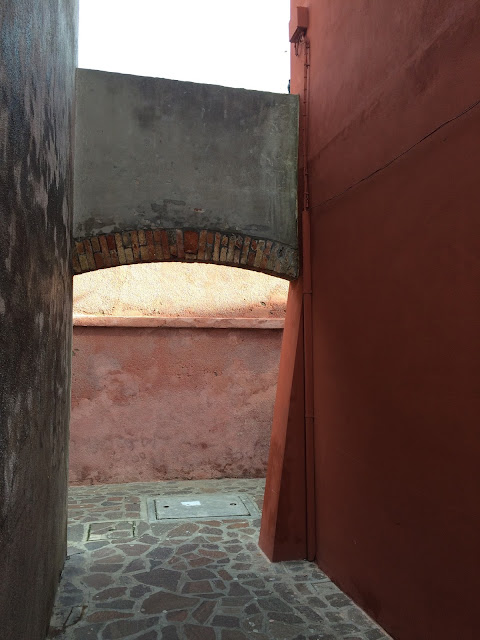Taking advantage of the clear, dry weather I decided to visit the islands of Burano and Murano on the afternoon of my second day in Venice. I bought a multi-stop vaporetto ticket and boarded line 12 at Fondamenta Nove, just a short walk from the Gesuiti church. If you look all the way in the distance you can see the snow-covered Alps.
Riding the vaporetto is an ideal sightseeing method. We passed in front of the cemetery island (Isola di San Michele), several small uninhabited islands with abandoned buildings in ruin, and made stops at Murano and Mazzorbo islands (at the latter there is a restaurant and boutique hotel called Venissa that I'd really like to try in the future, a proponent of "zero-kilometer sourcing"...sadly it was closed for the season).
After about 45 minutes on the boat we arrived at Burano, the island famous for its lace making tradition and brightly colored houses. I didn't focus much on the lace (I already have bags and bags of antique handmade lace from my family that I struggle to put to use) rather I spent my visit looking at the colors and taking photos.
Yes, Burano is touristy but it is possible to find some space to yourself, especially in the off season. All you need to do is take a few turns away from the main strip and start exploring. The palette and composition of this archway caught my eye, and from there I found a quiet series of back streets.

The repetition of rectangles, crumbling plaster, and marble crest on this façade hit all the right notes. I wished the business had been open, I was very curious about who and what went on inside.
I'd been to Burano once before, as a child, and I remember being bowled over by all the colors. Apparently there is an architectural preservation code in place and people have to maintain the hue of their house or building in a way that is faithful to history.
After a solid hour of exploring and photography, it was time for a late lunch. I found an outdoor cafe near the base of the church bell tower and ordered a grilled calamari salad and a glass of pinot grigio. Perfection!
The next stop on my island itinerary was Murano, the heart of Venice's centuries-old glass making tradition. I wasn't able to tour any of the factories due to the late hour, but I hope to do a fornace visit on a future trip.
There is a major connection between my jewelry work and Murano glass: this is the origin of many of the trade beads that were taken to Africa by the Portuguese. It blows my mind to realize that it was right here, 200-400 years ago, that artisans were making beads that would cross the world, be lost to sea because of shipwrecks, wash up on the beaches of Mozambique Island, be collected by local boys, and end up in my jewelry here in California...their destiny to be continued by the eventual wearer of the piece. The essence of Origins & Routes.
I enjoyed seeing this massive blue glass sculpture near the factories, a dose of contemporary art to contrast with all the history and remind us that this tradition is not dead. Although it is increasingly difficult to sustain, as is the case all around the world with artisanal production. Venice is full of cheap Chinese imports, and one must be careful not to buy knockoffs thinking they are original Murano glass.
I walked around the island for about an hour, and as the sun dipped down the photography became golden. The light on these boats was simply perfect.
In the absence of direct light, you get an even greater appreciation for all the colors on the buildings. I could have spent an eternity sitting on that red bench and taking in the atmosphere, but alas I had a ferry to catch.
The timing of my vaporetto ride back to Venice was impeccable. I watched the sky and water slowly shift from blue to gray, silhouetting the city in the distance. Seagulls dipped and dived all around the boat, fellow riders chatted in a dozen different languages, and I pulled my hood up tight around my face, a cocoon of warmth against the wind and sea spray.












No comments:
Post a Comment